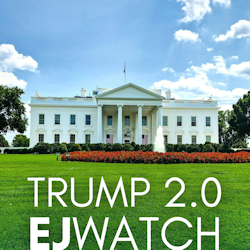SEJournal Online is the digital news magazine of the Society of Environmental Journalists. Learn more about SEJournal Online, including submission, subscription and advertising information.
 |
 |
| The earthen Menager's Lake Dam, southwest of Sells, Arizona, in 2018 after Tropical Storm Rosa, when the risk of failure threatened flooding and forced evacuations for residents of the Tohono O'odham Nation. Photo: U.S. Customs and Border Protection via Flickr Creative Commons (United States government work). |
TipSheet: Dam Safety Firings Leave Downstream Residents at Risk
By Joseph A. Davis
Don’t count on Elon Musk to save you from a catastrophic dam failure.
One of the first things the Trump 2.0 administration did upon taking office was to fire all the members of the National Dam Safety Review Board. So right now the best hope many residents in harm’s way have for staying safe is watchdogging by environmental journalists.
As Trump slashes agencies that
keep Americans safe
and healthy, the dam safety
story is getting bigger every day.
It’s a perennial story that’s timelier than ever. As Trump slashes agencies that keep Americans safe and healthy, the dam safety story is getting bigger every day.
It matters because when a major dam fails, people’s lives could be lost and property destroyed. The backstory is that the United States has been trying (though some would say not trying) to prevent those catastrophes for decades.
 |
Since the Johnstown Flood killed 2,208 people in 1889. Since the St. Francis Dam disaster killed over 400 Californians in 1928. Since 180,000 Californians below the Oroville Dam had to be evacuated in 2017.
There actually is a U.S. dam safety program. Or was. The National Dam Safety Review Board that Musk just fired was a big part of it. But hardly the only part: most U.S. dams are privately owned and state-regulated (if at all).
Other news suggests that it’s not an accident — that the Trump administration and Musk really are coming after dam safety.
The administration has also shut down the Army Corps of Engineers’ Risk Management Center in Colorado. And the DOGE bros are laying off other safety workers at the Bureau of Reclamation, which manages Western dams.
Story ideas
- Take a look at the National Inventory of Dams and locate any “high hazard” dams in your state. What populated areas would their failure threaten?
- Find out what condition those dams are in. This may be harder. When were they last inspected and what was their rated condition? Can you get the inspection report? Try your state engineer.
- Do the high-hazard dams in your area have “emergency action plans?” Can you get a copy? Will the plan keep people safe? Who’s in charge of notification and evacuation?
- Who regulates and inspects the dams in your area? Talk to your state engineer.
- Are any of your area’s dams in line to get federal money via the Inflation Reduction Act, Bipartisan Infrastructure Law, etc.? Is it being held up?
Reporting resources
- U.S. Society on Dams: A professional organization, nonprofit and nongovernmental, that shares knowledge about engineering.
- Association of State Dam Safety Officials: A good access point to the many state-level officials, often engineers, who work on the problem of dam safety.
- American Society of Civil Engineers: A professional organization of engineers working on all kinds of civil works, including dams.
- FEMA National Dam Safety Program: The Federal Emergency Management Agency is supposed to help people with all kinds of disasters. Their dam safety program has been one of the channels through which the meager federal funds are distributed to states.
- National Dam Safety Review Board: A federally established board of experts and officials that formerly oversaw U.S. dam safety. All of its members have been fired and its website deleted.
- Interagency Committee on Dam Safety: ICODS is “the permanent forum for the coordination of federal activities in dam safety and security.”
- Federal Energy Regulatory Commission: FERC is the federal agency that regulates hydropower dams. It is supposed to be independent.
[Editor’s Note: For more on dam safety, see our recent TipSheet, “Will Your Local Dam Turn Deadly in the Next Big Storm?” and Reporter’s Toolboxes on data for the nation’s disintegrating dams, updates on the National Inventory of Dams and finding stories with the database. We also have TipSheets on hydro relicensing, dam removal and the crisis for dams. WatchDog Opinion examines the dangers of dam secrecy and the information legacy of 9/11. There’s more, too, on covering inland flooding, flood risk disclosure, extreme rainfall and community resiliency. SEJournal has been coaching reporters on covering dam safety for years; find more background here and here. Plus, track headlines on dam reporting in the news via EJToday here.]
Joseph A. Davis is a freelance writer/editor in Washington, D.C. who has been writing about the environment since 1976. He writes SEJournal Online's TipSheet, Reporter's Toolbox and Issue Backgrounder, and curates SEJ's weekday news headlines service EJToday and @EJTodayNews. Davis also directs SEJ's Freedom of Information Project and writes the WatchDog opinion column.
* From the weekly news magazine SEJournal Online, Vol. 10, No. 14. Content from each new issue of SEJournal Online is available to the public via the SEJournal Online main page. Subscribe to the e-newsletter here. And see past issues of the SEJournal archived here.













 Advertisement
Advertisement 



